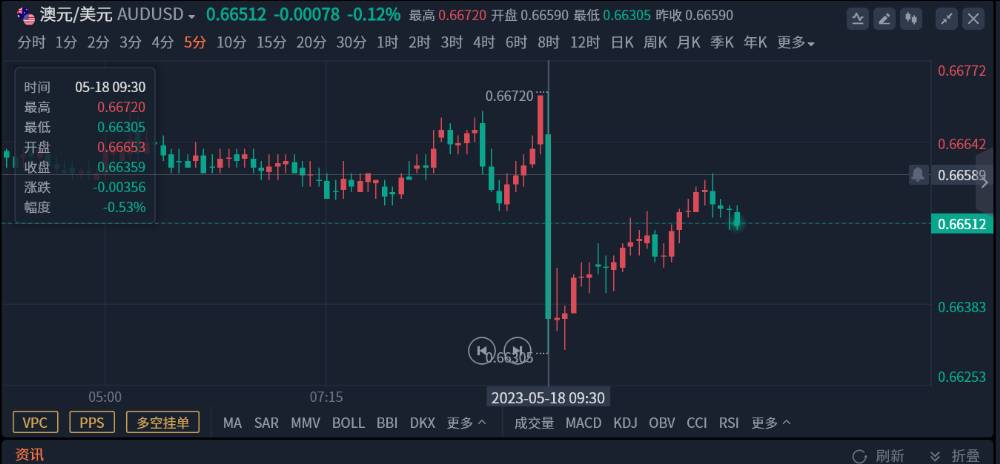Australia's unemployment rate has soared unexpectedly! Does the RBA dare to continue raising interest rates in June??
On May 18, the Australian Bureau of Statistics released Australia's April quarter-adjusted unemployment rate.。The data shows that the data recorded 3.7%, higher than the expected value of 3.5%, the first rise in the year。
On May 18, according to the Australian Bureau of Statistics, Australia's unemployment rate recorded 3.7%, higher than the expected value of 3.5%, the first rise in the year。Previously, Australia recorded 3 in February and March this year..The quarterly unemployment rate of 5% is the lowest in nearly 50 years.。
Specifically, employers lost 4,300 jobs compared to the previous month, with full-time jobs falling the most, while the market was surprised by the expected increase of 25,000 jobs.。After the data was released, Australia and the U.S. dived 35 basis points in the short term, then recovered from the shock and are now trading at 0.66512。

Increasing employment and controlling inflation are the eternal propositions of every central bank during the formulation of monetary policy.。In April, the RBA was the first to announce that it would keep the policy rate at 3.6% level, becoming the first major developed country central bank to suspend interest rate hikes since the outbreak of the banking crisis.。Previously, in the context of global central banks seeking to control inflation, the bank has raised interest rates 10 times since May last year, a total of 350 basis points。
At the time, the RBA said there was a lag in monetary policy and that the impact of the previous sharp rate hike had not yet been fully felt, so it decided to keep rates unchanged to allow more time to assess the impact of the rate hike and the economic outlook.。
As we enter May, the RBA's just-suspended rate hike is suddenly changing again。On May 2, the bank announced that it would raise its benchmark interest rate by 25 basis points to 3.85%, a new high since 2012, caught the market by surprise。In response, the RBA said 7 per cent inflation was still too high and it would take some time to return to the target range.。In addition, the bank gave its own inflation outlook, which is expected to be 4.5 per cent, which could fall to 3 per cent by mid-2025。
However, on the employment issue, the RBA is quite confident, suggesting that the strong employment data gave the bank the strength to raise interest rates。In its rate decision statement, the RBA said: "Recent Australian data confirm that the labour market remains very tight and unemployment is close to its lowest level in 50 years.。"
Protecting Prices or Protecting Employment?Against the backdrop of a standstill in April, what the RBA has observed through a one-month policy fermentation period is still high inflation, while Australia's unemployment rate is at historically low levels during this period.。Clearly, the RBA did not want its year-long anti-inflation efforts to be in vain and chose the former first in this game。
Just didn't expect that this time it was the RBA's turn to be caught off guard。
Some analysts pointed out that the weak employment results show that while the surge in immigration has inflated the size of the workforce, the RBA's 11 rate hikes in the past year are putting pressure on the corporate sector, reinforcing the RBA's maintenance of its benchmark interest rate at 3 on June 6..85% of the reasons for the same。
In addition, only Goldman Sachs among the big banks now expects the RBA to raise interest rates by another 25 basis points, while many others, including the Commonwealth Bank of Australia, say the RBA's tightening cycle is over。
Sean Langcake, head of macroeconomic forecasting at the Oxford School of Economics, said Australia's labor market is expected to gradually weaken this year.。He also said whether today's data is the start of the process or just typical volatility will be a key issue for the RBA to discuss at its upcoming meeting.。
Previously, according to RBA Governor Philip Lowe (Philip Lowe), he wanted Australia to both maintain the job growth it has achieved since the epidemic and bring inflation down to its policy target of 2-3%。
Obviously, the current situation, fish and bear's paw can not have both, for the two key indicators of the trade-off, the Australian Federal Reserve officials need to weigh the issue.。
Eagle Statement: This article is for reference only and does not constitute personal investment and operational advice.。Special reminder, the article is original content, without permission may not be reproduced。
·Original
Disclaimer: The views in this article are from the original Creator and do not represent the views or position of Hawk Insight. The content of the article is for reference, communication and learning only, and does not constitute investment advice. If it involves copyright issues, please contact us for deletion.